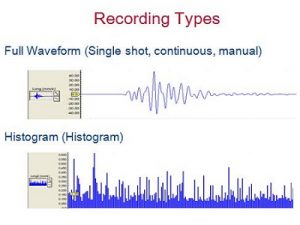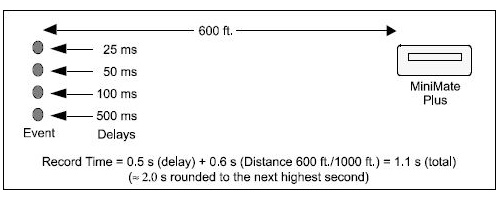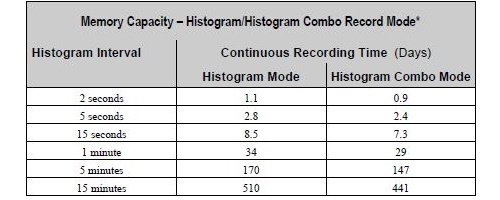
Ground Vibration Monitoring Recording
Different types of ground vibration monitoring recording modes.
Instantel’s Minimate Plus possesses five different recording modes: Single Shot, Continuous, Manual, Histogram, and Histogram Combo. Likewise, Instantel’s Blastmate III possesses these same five recording modes.
Read over each ground vibration monitoring recording type to decide which mode is best for your survey.
Ground Vibration Monitoring Recording Modes:
Single Shot:
The Single Shot recording mode records exactly one event. In other words, once a seismic or airblast source meets a programmed threshold, the ground vibration monitor records that one event and then stops monitoring. After an event, it saves the record, displays the results, and awaits instruction. If not given instruction, the monitor shuts off after a period of inactivity.
Continuous:
Similar to the Single Shot mode, the Continuous recording mode records an event once a seismic source meets a programmed threshold; however, the monitor continues recording after an event triggers. It monitors unattended except when the operator stops monitoring to transfer data and process it. Because of the monitor’s ability to continually record events, it is important to program high enough thresholds that do not record unwanted vibration or sound pressure. Additionally, in this mode, the operator should periodically confirm the ground vibration monitor’s memory. If memory is close to capacity, the operator should transfer events to a computer and delete the results on the ground vibration monitor before resuming.
Manual:
The Manual record mode records an event when triggered by the operator. This mode is often used when automatic triggers are unreliable due to certain conditions: excessive wind, nearby traffic activity, or background noise in close proximity to the recording site. Operators also use this mode to capture a record of the background noise. When set to record an event manually, the minimate or blastmate ignores all other programmed threshold criteria.
Histogram:
The Histogram record mode, also known as the Strip Chart record mode, monitors continuously over a long duration and stores summary event information in intervals rather than the real time continuous method used in the other record modes. In other words, this mode does not record full waveforms. Instead, it constantly samples data at a chosen sample rate but only stores the relevant peaks for the interval. Therefore, it can gather a large amount of information while greatly increasing the monitor’s recording time. For each interval, the monitor calculates the maximum positive and negative peaks, the frequency of the largest peak, and up to two peak vector sums (one with four channel monitors, two with eight channel monitors). For each channel, the maximum peak, its frequency, and the largest peak vector sum is calculated over the entire event.
Histogram Combo:
The Histogram Combo record mode is aground vibration monitoring recording combination of histogram’s interval recording and waveform recording. In essence, the ground vibration monitor records in histogram mode while also recording a waveform event if the signal reaches a programmed threshold for waveform events. The Instantel ground vibration monitors store the waveform events separately from the histogram event. Up to 13 waveform events can be stored without transferring data to a computer and deleting the waveform events on the blastmate or minimate. The auxiliary trigger is disabled during histogram combo mode. The maximum sample rates in this mode are 2048 samples per second for 4 channels or less and1024 samples per second for more than 4 channels.
Whenever recording in Histogram or Histogram Combo mode, it is important to watch the monitor’s battery and memory levels. Keep the Instantel ground vibration monitor plugged in if possible.
To set the record mode, press the SETUPS key. Press the enter key to display the Recording Mode window. Next, press the up key or right key to scroll through the record. Finally, press the enter key to select a record mode when it appears on the display.
Different types of ground vibration monitoring recording stop modes.
If the operator selects a full wave form recording type (single shot, continuous, or manual mode), the operator must program a record stop mode. The Instantel ground vibration monitor possesses two record stop modes: fixed or auto. The fixed or auto ground vibration monitoring recording modes do not apply to histogram or histogram combo mode. If the operator selects a histogram mode, the operator programs the histogram interval to control the period of time before the monitor applies its data analysis techniques.
Fixed or Auto Record Stop Modes:
Fixed:
A fixed setting records for a predetermined amount of time after an event meets the programmed trigger level. When programming a fixed time, it is important to set the time long enough to capture the full event while making it short enough to not waste memory resources. A useful rule of thumb for determining a fixed amount of time is to add the delays between detonating holes or use the longest delay, then add one second for each one thousand feet (300 m) from the event to the ground vibration monitor to account for the speed of sound and then round to the next highest second.
For example, in the figure below the minimum record time required for 600 feet is 2 seconds. This is calculated by adding the delay time of 0.5 second and adding 0.6 second since the source is 600 feet away (1 second per 1000 feet). 0.5 + 0.6 = 1.1 second. To be safe, the operator rounds up to the next second and sets the record time to 2 seconds in order to capture the complete event’s activity. Ultimately, there is no single method for setting a record time. Use your knowledge and experience to determine an appropriate ground vibration monitoring recording time.
Auto:
An auto setting records activity for as long as an event remains above the programmed threshold given there is sufficient memory and battery power. After activity falls below the threshold, the monitor records for a programmed amount of time. This time is set in the Auto Window on Instantel’s minimate or blastmate.
The total record time available depends upon the amount of available memory. The Instantel ground vibration monitors check your setup to determine the amount of available memory. If there is not enough memory, a warning message appears and the record time defaults to the maximum available.
To set the record stop mode, press the SETUPS key when the main menu window is displayed. Press the enter key to scroll though the windows until the Record Stop Mode window appears. Next, press the up or right key to display either the Fixed setting or the Auto setting. Press the Enter key to save your setting when it appears in the display.
Histogram Interval (Histogram and Histogram Combo Modes):
In histogram and histogram combo record modes, the Intantel ground vibration monitor displays the histogram interval menu instead of the record stop mode menu. The histogram interval is the period of time the monitor records event information before applying data analysis techniques. For each interval, the ground vibration monitor calculates the maximum positive and negative peaks, the frequency of the largest peak, and up to two peak vector sums (one with four channel monitors, two with eight channel monitors). For each channel, the maximum peak, its frequency, and the largest peak vector sum is calculated over the entire event.
The table below lists approximate recording times for different histogram intervals. The table assumes the monitor possesses an available memory of 300 events (960 kB) and ample battery power.
Obviously, as the monitor’s event memory increases, the ground vibration monitoring recording time increases as well. For example, if the monitor’s event memory increases by three megabytes, the recording time increases by a factor of three. Increasing or decreasing the monitor’s sample rate does not affect recording time. For instance, increasing the sample rate from 1024 to 2048 samples does not affect the recording time. On the other hand, if the recording channels increases to eight from four, the recording time values decrease by approximately one half.
Increasing the Ground Vibration Monitoring Recording Time in Histogram Mode
Recording time in histogram mode increases by turning off either the geophone or microphone channels. It also increases when using the timer to record only time periods with activity. Turning off the geophone channels increases the record time by 80%. Similarly, turning off the microphone channel increases the recording time by 20%. The operator can use the timer mode to record only time periods when events occur and therefore free up the memory space and battery life that otherwise would be used. As an example, setting the timer to record for eight hours a day as opposed to twenty-four hours will increase the histogram records time by threefold.
To set the histogram interval, ensure you have chosen the histogram or histogram combo record mode. Press the SETUPS key when the main menu window is displayed. Press the enter key repeatedly until the Histogram Interval window appears. Next, press the up key or right key to select an interval. The available intervals are 2, 5, and 15 seconds and 1, 5, and 15 minutes. Press the enter key to save your setting.
Note: When exiting the histogram record mode, the last incomplete interval may not be saved. If the password feature is enabled, the last few intervals may not be saved.


